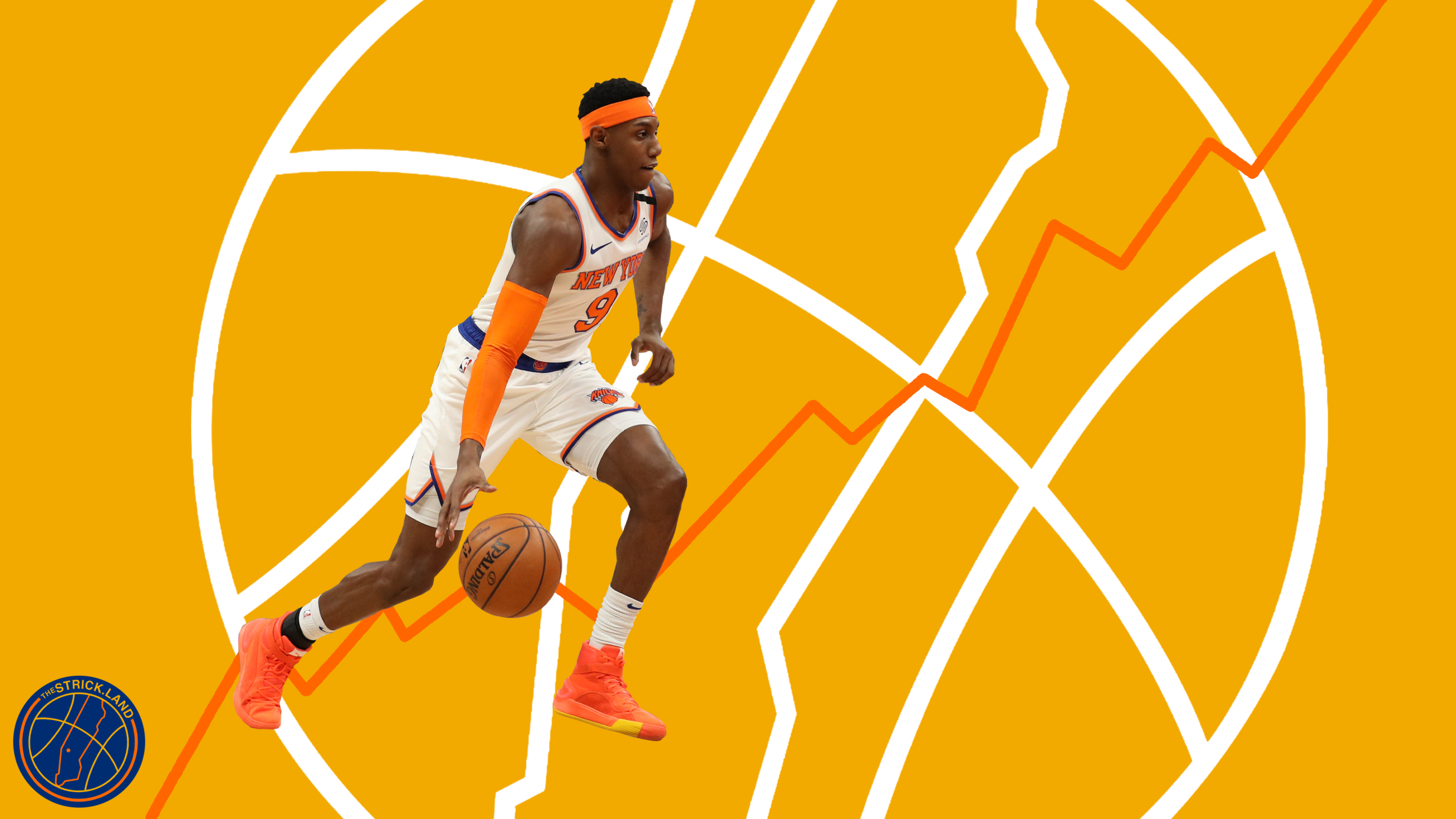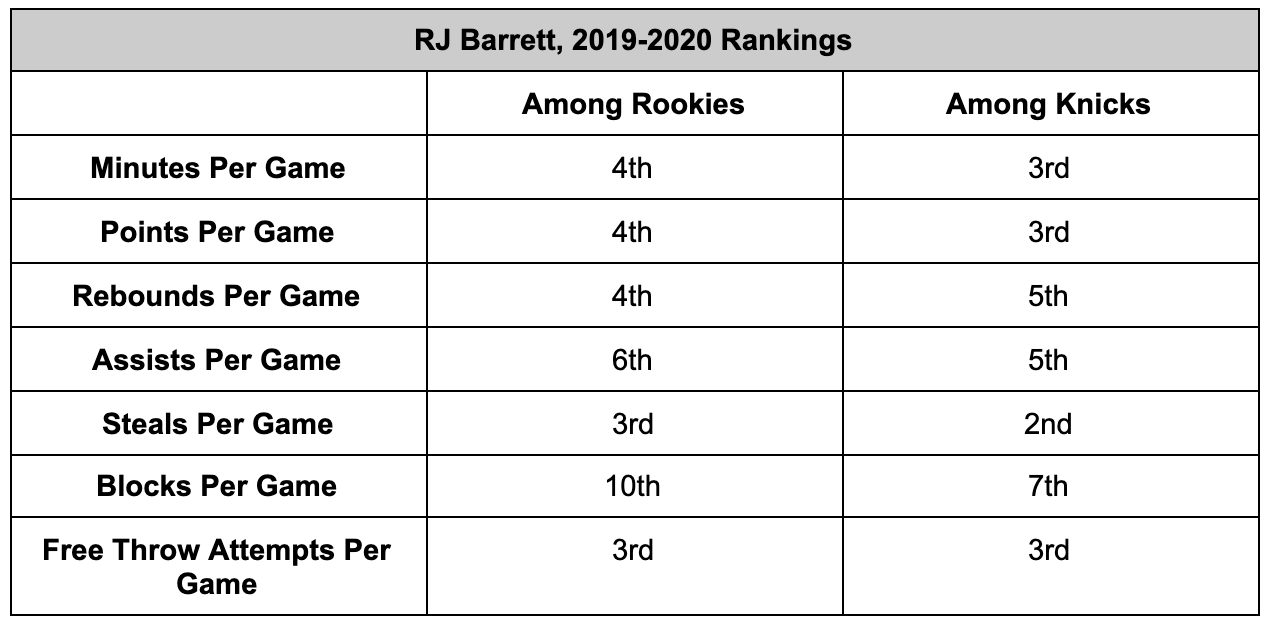No All-Rookie? No problem: Projecting RJ Barrett’s future
The third pick in the 2019 NBA Draft failed to make an All-Rookie team.
However, you’d be hard-pressed to find a Knicks fan that was significantly disappointed by RJ Barrett’s rookie season. Though he didn’t light up the league immediately like Ja Morant or Zion Williamson, RJ showed a little bit of everything in what was a significantly featured role for the Knicks. Operating at an incredibly high volume, he filled up the stat sheet like few other rookies in the league — and few veterans on his own team:
The numbers are pretty impressive all around; although he didn’t dominate any particular category, he was top 10 (or well better) everywhere. Of course, that then begs the question: how exactly did this kid miss not one, but two All-Rookie teams?
Was it a classic case of anti-Knicks media bias? Perhaps a bit. The most significant schism here, though, in my opinion, is how the voters view the volume/counting stats like the ones above in juxtaposition to the more advanced stats — rate-based and on/off numbers — in which RJ struggled. Heck, the stats don’t really need to be all that advanced to see a player with significant efficiency problems — his 40%/32%/61% shooting line calculates out to under 48% true shooting, an abhorrent number that ranked second-worst in the entire NBA this season.
Of course, whether or not RJ is a real future building block shouldn’t be judged by an award that got Knicks fans hyped up about the likes of Willy Hernangomez and Landry Fields. However, it’s worth wondering just how concerned the Knicks should be about RJ’s efficiency problems, especially considering the fanbase’s proclivity to overhype their rookies. After all, a Latvian big man who need not be named was being referred to as something along the lines of “God” after averaging 14.3 points per game his rookie season at the Garden. That 14.3 number eerily happens to be identical to RJ’s season average, and was achieved both with better shooting efficiency (52% TS for Porzingis) and ostensibly higher defensive potential.
Porzingis wasn’t hyped up for his season averages, though. What really anoints a Garden rookie is the flashes of brilliance — the high highs that pop up, for such a young player, among the usual weeks of mediocrity. Regardless of whether you believe the Kendrick Nunns (25 years old) and Terence Davises (23 years old) of the world did have “better seasons” than RJ, it’s the flashes that RJ undeniably provided in his age-19 season that keep him so enticing as a prospect — yet also continue to muddy his evaluation.
Let’s dive into a case study. Take perhaps my favorite RJ game of the season: Jan. 5 against the Los Angeles Clippers. On the road, on the west coast, against perhaps the best perimeter-defending team (on paper) in the NBA, RJ showed his full tantalizing repertoire.
For his first bucket, he capitalized off the turnover, patiently pushed down the floor with his head up, then attacked the defense at the perfect moment, blowing by three-time All-Defensive player Patrick Beverley to the cup with his off hand:
Was that a fluke? Nowhere near it. Just two minutes later, he has another transition opportunity, and in what amounts to essentially a 1-on-4, puts the shake and bake on four-time All-Defensive player Paul George, then finishes with the hoop and the harm:
PG isn’t off the menu just yet, though. RJ can run pick-and-roll in the half court, too. Here, the (barely) screen gives RJ just the sliver of daylight he needs to gather and beat George, circling and swirling across the paint to the cup:
So we know he can score in transition and off pick-and-roll, but is he useless off the ball? Landry Shamet seems to think so, so he leaves RJ wide open in the corner on this play. Kadeem Allen (RIP) finds him easily and RJ calmly knocks down the triple:
The Clippers just saw him in the first quarter run pick-and-roll from the right wing and blow by an over-the-screen defender all the way to the cup. They make the adjustment here. Beverley goes under the screen instead, but RJ simply takes what the defense gives him, getting to his spot and calmly rattling in the jumper:
“Alright,” say the Clippers, “No more letting the rookie get to his strong hand off the pick-and-roll. In the second half, we’ll force him right.”
“Sure,” says RJ. “I’ll go right and step back on that side for cash”:
Almost a full quarter later, RJ’s back on the court and every play is getting more important — down five with just under four minutes to go in the game. What if he can’t get in transition, pick-and-roll, or spot up? Let’s try give-and-go! RJ bops Lou Williams with a ball fake, then takes off to the hoop, and though he doesn’t finish immediately, he perfectly times the put-back a la Carmelo Anthony (more on that later) to cut the deficit to three:
RJ got just 11 field goal attempts that night, but those 11 attempts yielded seven makes (64%)::
Transition right-handed finish
Transition left-handed finish
Left pick-and-roll layup
Left pick-and-roll pull-up
Spot-up three
Right pick-and-roll pull-up
Give-and-go layup
RJ was also 9-11 from the free throw line that night (82%), good for the most free throws made in a game in his young career.
Of course, if RJ had games like that more often, he certainly would have made an All-Rookie team, anti-Knicks bias or not. That performance was an exception to the rule this season, his fifth-highest Game Score out of 56. He was wildly inconsistent — I charted a seven-game moving average of his Game Scores, and though there is reason for optimism (he spiked at the end of the shortened year — his highest score was on the last game of the season), it looks like it very well may be just a bunch of noise:
And it’s not like the Knicks haven’t seen rookies have mostly-poor seasons with high highs then not pan out… recently. Kevin Knox, who many Knicks fans would now be willing to trade for a slice of Prince Street Pizza, won NBA Rookie of the Month in December 2018, in a year where he not only missed out on both All-Rookie teams, but ranked an abysmal 512th in the NBA in ESPN’s Real Plus-Minus. This season, RJ ranked 488th.
That brings us back to the question of player projection. What’s more important? Early statistical results or general tools? Although they had relatively similar rookie years statistically, RJ and Knox have left immensely different impressions on the Knicks fanbase, if on them alone.
FiveThirtyEight’s player projections also agree that RJ was a negative this past season, but see slow and steady improvement in his future by wins above replacement player, enough to categorize him as a “good prospect”:
Compare those results to someone like Kendrick Nunn, who made the All-Rookie First Team, and by most efficiency-based metrics, did indeed have a better season than RJ. A higher wins above replacement in 2019-20, but not projected to touch RJ the rest of his career; a “marginal prospect”:
Think back to Willy Hernangomez and Landry Fields. It’s sad that Barrett — our guy! — didn’t get recognized for this (minor) award, but that’s not really what’s important here.
It’s okay to admit RJ didn’t have a fantastic season — yes, he ranked highly among rookies (and Knicks) in counting stats, but a bunch of empty volume stats on poor efficiency for a bad team would normally earn the ire of sports fans, not the love. And justifiably so! However, I could write another full column on how poorly a situation RJ was put in to succeed in his rookie year, by everyone in the organization from the GM, to the coaches, down to his teammates. Elfrid Payton hunting triple doubles, Julius Randle’s “spacing” on the wing, and Marcus Morris thinking he’s Carmelo Anthony is a tough environment for a young kid to succeed, especially after the offseason the Knicks had in the city the Knicks had it in. But who’s the real Carmelo Anthony? FiveThirtyEight’s aforementioned player projection tool has a player similarity feature that can pull in the top 10 most comparable players in NBA history to any given player. Here’s RJ’s:
Knicks fans should enjoy RJ Barrett for what he is. Sure, his NBA career won’t be defined by his low Real Plus-Minus ranking, but it also won’t be defined by ranking fourth among rookies in minutes. A guy who can score in multiple ways and rebound effectively, while not looking like a total liability passing or on defense, has a chance to be a real building block for a winning NBA team. He’s no savior, but he’s got a deep bag and a good attitude. And if you believe in bulletin board material, losing out on an All-Rookie team is a pretty good thumbtack to start with.







